What Is Tack Welding And How Does It Work
The world of welding is complex, so we are seeing various welding processes, techniques, methods, and approaches. Nonetheless, each welding process has the same goal - creating an everlasting, strong, and resistant bond between two pieces.
However, there are some specific tips and tricks that will help you keep your pieces in place and prevent warping and distortion during the welding procedure. That's why we'll explain what is tack welding process and how it works.
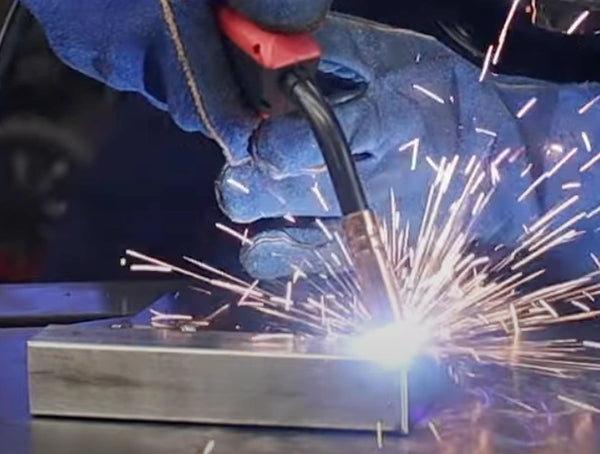
What Is Tack Welding? Understanding Its Purpose and Importance
Tack welding is a temporary welding process used to hold pieces of metal together in the initial stages of a welding project. The primary purpose of tack welding is to secure the workpieces in the correct alignment and position before the final welding process occurs.
Tack welding allows for careful adjustment of the position and alignment of the workpieces before committing to the final weld. Providing a stable and secure base lets you focus on creating strong, consistent, and high-quality welds without the concern of pieces shifting or misaligning.

Source: https://www.worthyhardware.com/news/tack-welding/
Additionally, tack welds help minimize distortion or warping of the metal during the final welding process, make it easier to perform the final welding process, and can save time and costs by ensuring that the welding process is more efficient.
How Tack Welding Works?
Tack welds are performed during the fit-up part of the welding process, which is considered part of weld preparation. During the fit-up, welders position and align two pieces, ensuring an even gap between them. Now, you can clamp the pieces to ensure they stay in place, but you can also create several temporary welds, known as tack welds. Clamping is always a good option, but as a beginner or occasional welder, buying fixtures is often not worth the money, as you'll achieve the same results with tacks.
Even though tack welds are minor and temporary, creating tack welds is still considered a type of welding. They are usually between one-half inch to three-fourths inches long, and they never exceed one inch. The welds are usually performed using the same materials and process as the final weld but typically at a lower power level or heat input.

Once you've tack welded two pieces, you can rework them if there are any mistakes or decide to apply a permanent weld. You can melt and weld over the deposited tack welds, but if you do so, you should clean them to avoid oxides from building up in the middle of the weld.
Types Of Tack Welds
There are several types of tack welds that welders use, and the most common types of tack welding are:
- Standard tack welds
- Bridge tack welds
- Hot tack welds
A standard tack weld is the most basic type of tack weld you will likely use as a hobby or beginner welder. These welds are deposited into the welding joint and intended to be consumed by the final weld joint gap.
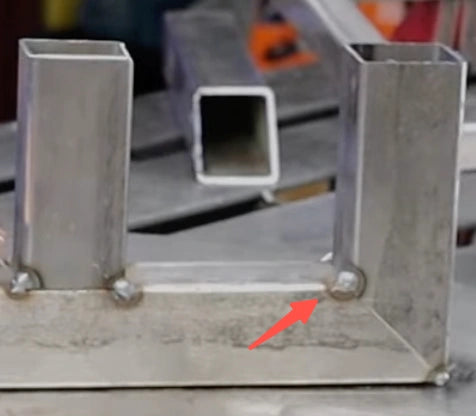
A Standard Tack Weld
Source: https://www.youtube.com/watch?v=yyTv8dXZwTM
A bridge tack weld is a bit more advanced and is typically used when there is a gap between two pieces. The most common cases are when there is a root opening in pipes or the miscut parts and other mistakes. Welders create two small tack welds on both pieces of the joint, and once they cool down, they add another one to create a bridge tack weld on the outside of the joint. Compared to other tack welding methods, bridge tack welds do not penetrate the root of the joint, so you can remove them after depositing the root pass.
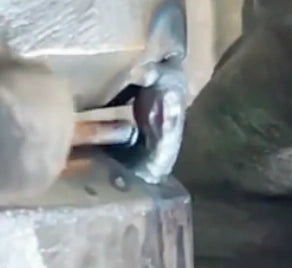
A hot tack weld is a great way to close the gaps between the two pieces by using excess filler metal, heat, and force, but at the price of weld quality. You apply the filler material and heat to pieces, and then use a hammer to close the gap. The extra heat can cause a powerful contraction, and as the metal cools, you can beat the gap to close it. Hot tacks are a quick and efficient method of closing a gap between two metal parts, but welds are likely to fail the quality check.

Forms Of Tack Weld
Depending on the specific application, there are several forms of tack welds. The most common forms of tack welds are:
- Square tack welds: square tack welds are tack welds made in a square or rectangular formation. This form is usually used on flat surfaces where the pieces need to be held at a specific distance from each other.
- Vertical tack welds: vertical tack welds are used when the workpieces are positioned vertically. The welder applies the tack welds in a vertical direction.
- Right-angle tack welds: This type of tack weld can be used when the metal pieces you want to join sit perpendicular to one another.
- Right angle corner tacks: Used once joining two perpendicular pieces of metal together, which will result in a T-shape.
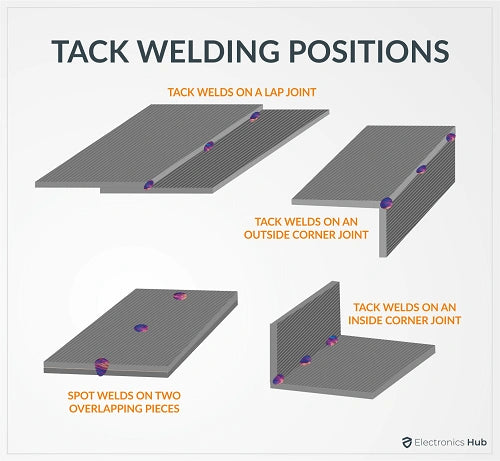
Source: https://www.electronicshub.org/tack-weld/
Tack Weld vs. Spot Weld
Due to the size and appearance of the welds, many welders consider tack welding and spot welding processes to be similar. Both processes yield small welds in the form of dots, but the very nature of these two processes is different.
Unlike tack welding, spot welding is an independent weld process that utilizes heat and pressure to create welds on thin metal materials. Two electrodes apply current, heat, and pressure to the two pieces and create permanent welds in the form of tiny dots (spots). This process doesn't use any filler material and can yield pretty strong welds on thin materials or wire mesh, which is often in the autobody industry.

Source: https://www.worthyhardware.com/news/tack-welding/
Meanwhile, we already stated that tack welding includes creating temporary welds that hold the pieces together. Due to the different nature of the process, a tack welder can be any regular welding machine that can use Stick welding or Flux cored welding. Spot welding, on the other hand, uses specialized equipment.
Observing symbols is a good way to remember the difference between tack and spot welding. There is no official tack weld symbol, but the spot weld symbol uses a plain circle. A circle can be placed above, below, or on the reference line to show tack welds, while tack welds are used as temporary help.

Spot Weld Symbol
Source: https://www.uti.edu/blog/welding/tack-welding
Challenges Of Tack Welding
Tack welds must be strong and reliable, and they must provide proper alignment throughout the process, but achieving that is not always easy. The goal is to support the final welding process, so tacks should maintain the quality of the finished weld. Using wrong procedures or tacks that differ from the base metal will create weak spots in the weld. Improper tack weld configuration can also affect the joint quality and cause failures.
In addition, applying tack welds on structural steel and metals commonly used for fabricating pipes and vessels can result in quenching and cooling. Rapid quenching or cooling can create brittle and hard, crack-sensitive microstructure. Once the final weld is exposed to stress, cracks can appear in the defective area. Since you are welding over the tacks, small cracks can form inside the weld, which makes them hard to detect. These cracks expand over time and eventually lead to a fracture.
The common risks of improper tack welding are:
- Cracks
- Craters
- Accidental arc strikes
- Excess slag buildup
- Hard spots prone to cracking
- Weld oxides buildup

Proper Way to Tack Weld And Create Strong Final Weld
Since there are various risks that poor tack welds can create, there are specific guidelines on the right way to tack weld provided by reputable organizations such as the American Welding Society (AWS). They state that tack welds should be firm and sized appropriately so they can hold up and manage the weight of the materials. The number of tack welds must be appropriate to the size of the weld.
Tack welds can be deposited inside or outside the joint, melted, welded over, or removed after welding, which will depend on specific applications. The primary rule when making tack welds is to use clean and strong filler metal with composition compatible with weld metal. Typically, the same welding processes (MIG welding, Stick welding, TIG welding, or Flux core welding) are used to tack and deposit further permanent welding beads.
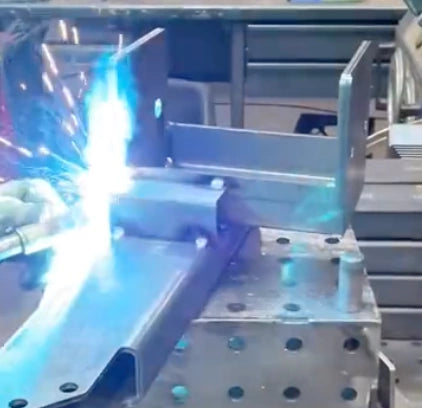
When welding over the created tack welds, clean them to avoid oxide buildup. Deposited metal can create oxidation on the surface, and if you weld over it, you'll create a weak spot inside the weld. The joint can fail once exposed to external welding stresses due to poor tack weld inside.
Even though tacks are done at lower amperage, the welds need to be capable of resisting transverse shrinkage to create adequate weld penetration. Despite being temporary, tack welding quality is still essential, and best practice is required to ensure the joints are good enough to serve their purpose.
Pros and Cons Of Tack Welding
Tack welding is a valuable technique in welding processes, but like any method, it comes with its own set of advantages and disadvantages. Here are some of the pros and cons of tack welding.
Advantages of tack welding
- Alignment and Precision: Tack welding allows for precise alignment of workpieces before the permanent welding process, ensuring that the pieces are in the correct position and orientation. This is crucial when weld precision and quality are essential.

- Adjustability and Flexibility: Tack welds can be easily broken when adjustments are required, which provides flexibility in the assembly process. They will allow you to make corrections before depositing the permanent weld.
- Reduced Distortion: Tack welding helps minimize distortion or warping of the metal during the final welding process. Tacks will keep the pieces in place and prevent them from shrinking or expanding due to the heat of an arc.
- Enhanced Safety: Tack welding provides a stable and secure base, reducing the risk of accidents or injuries during the welding. Clamping and fixating pieces is a crucial, safe practice when welding.

- Quality Control: Tack welding allows for a thorough inspection of alignment and fit-up before proceeding with final welds. Weld preparation is crucial in ensuring and producing the highest quality welds; inspectors can ensure everything is in its place.
- Time and Cost Savings: Tack welding can save time and costs by reducing the likelihood of errors and defects due to poor fit-up. These defects will often require a rework, which can be time-consuming and expensive in large-scale industries.
- Material Versatility: Tack welding can be used on various metal pieces and a material thickness. Even though some will require more or less expertise to deal with, it is pretty versatile.
- No Specific Equipment Required: You can create tack welds without requiring specialized equipment or welding machines. As a beginner, you don't need to buy fixtures to clamp your pieces in place, and some welders will even have a spot timer for multiple tacks.

Disadvantages of Tack Welding
- Weakened Joints: Tack welds are generally smaller and less robust than final welds, so they contribute less to the overall strength of the joint. Poor filler metal can only create weak spots inside the welds and weaken the joints.
- Additional Welding Steps: Tack welding adds an extra step to the welding process, which may increase overall project time and labor costs. This is important for large-scale production, where each part of the equation can impact the overall welding costs. However, you probably won't feel high effects as a beginner.

- Potential for Incomplete Fusion: Improperly executed tack welds may result in incomplete fusion, leading to weaker joints in the final weld. Tacks are performed at lower temperatures, creating a lack of heat and improper penetration.
- Residual Stress: Tack welding can introduce residual stresses into the workpieces, which may need to be addressed to prevent tack welding issues like distortion or cracking. This is common for tricky materials that don't handle the rapid, localized heating and cooling.

- Requires Skill: Tack welding needs skill and experience to be done effectively. Beginners can struggle to perform tacks on large parts or areas near the edge of parts, so like other welding processes, it requires some time and patience.
Alternatives To Tack Welding
The alternative to tack welding depends on the specific requirements of the welding project and the desired level of precision in aligning and securing the workpieces. Some other options for tack welding include:
Clamping includes using clamps or fixtures to hold the pieces in the desired position before welding, but it does not involve any welding.
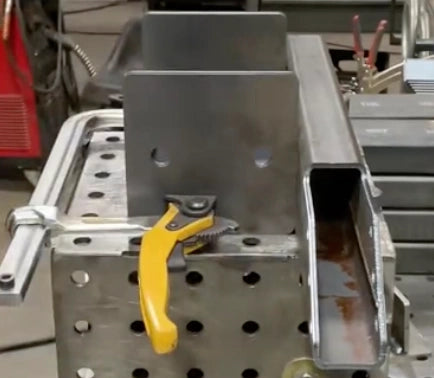
Magnetic Fixtures: a quick and easy way to align pieces that can be used in situations where clamps may not be practical. However, the use is limited to ferrous metals.
Jigs and Fixtures: this includes using custom-made jigs and fixtures to hold the workpieces in the correct alignment. It is ideal for mass production or projects with repetitive welding requirements, but building them can be time-consuming or expensive.
Temporary Fasteners: temporary fasteners like screws or bolts will hold pieces together and offer a secure and adjustable method for holding pieces in place. However, they will require some more work and time.
Stitch Welds: tack welding method with intermittent welds along the joint, which requires careful planning to ensure proper alignment.

Conclusion
Tack welding is a crucial step in welding, providing precision and alignment. Its intermittent welds secure workpieces, allowing adjustments for accurate final welds. Tack welding reduces distortion, enhances safety, and facilitates efficient welding processes.
Despite its benefits, tack welds are smaller and less robust, necessitating careful execution to avoid weaknesses. When used judiciously, tack welding is an invaluable tool for welders seeking accuracy and high-quality results in metal fabrication.
🧐What Is Tack Welding And How Does It Work FAQ
1. What Is Tack Welding?
Tack welding is a temporary welding process used to hold pieces of metal together in the initial stages of a welding project. Its primary purpose is to ensure correct alignment and positioning before final welding.
Tack welds enable precise adjustments before committing to the final weld, ensuring stability for strong, consistent welds without concerns of misalignment. They also minimize metal distortion, facilitating the final welding process and enhancing efficiency, ultimately saving time and costs.
2. What are the types of tack welds?
There are several types of tack welds that welders use, and the most common types of tack welding are:
-
Standard tack welds
-
Bridge tack welds
-
Hot tack welds
👏 You may be interested in the following:




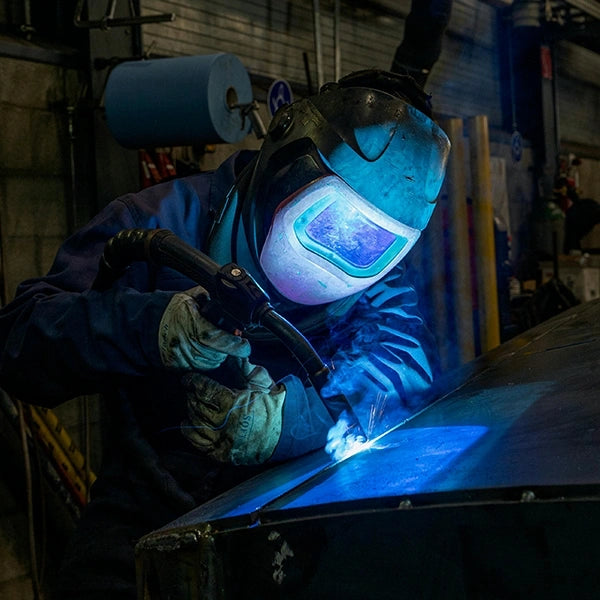


Leave a comment